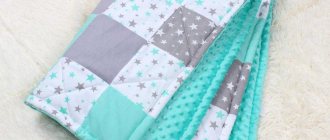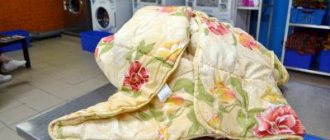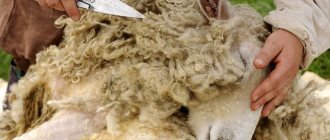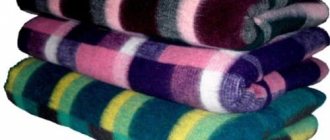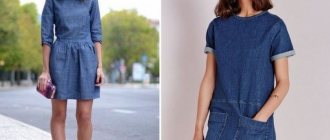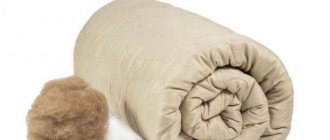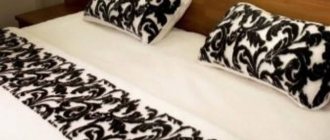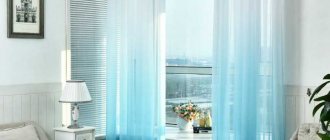A person spends about a third of his life in a state of sleep, but whether his sleep is quiet or disturbed largely depends on bedding, a comfortable bed, and a good soft blanket. Choosing a blanket should be given no less time than choosing a comfortable, healthy mattress of the required hardness. In this article we will determine which is better - camel or sheep wool, blankets from which are sold in an equal number of models.
Sheep wool blankets: basic concepts of material
These blankets have a number of advantages, but there are also disadvantages that should be considered. The main features of sheep wool and blankets made from it are the following:
- A blanket made from sheep's wool is twice as heavy as a similar size product woven from camel wool. Despite this, sheep's wool is much cheaper.
- A sheep's wool blanket can retain its original shape for quite a long time, all thanks to its natural "curly" wool.
- The main advantage of a sheep's wool blanket is its excellent thermal insulation. These products are incredibly warm.
Important!
Something else you need to know before purchasing a sheepskin blanket is that it is impossible to clean it yourself. Even if you use a delicate washing cycle, this will be impossible to do - the blanket will immediately become rough and unsuitable for further use.
Types of blankets
There are two types:
- with closed wool or quilted. Available in a fabric case. This is the most popular variety. Blankets of different densities can be selected for any time of year: light (density up to 150 g/m2) for summer, all-season (up to 300 g/m2) for use at any time of the year, warm (from 400 g/m2 and above) for winter and cold rooms;
- with open wool or woven. There are double-sided and single-sided models with a polyester or satin base. This type of product is often used as blankets or bedspreads. It is believed that it is blankets with open wool that have maximum healing properties. The healing lanolin from the wool is thus more easily transferred to the skin and joints of the person covered with this product.
Camel wool blanket
A camel wool blanket is very soft and, most importantly, warm. At the same time, it’s great to sleep under it at any time of the year. This product breathes quite well and absorbs moisture well.
The filling for blankets made of camel wool is heterogeneous, as it consists of hard fibers and soft down. Thanks to this, you can warm up under such a blanket in just a few minutes.
Important!
Camel blankets are distinguished by their quality and softness; their composition greatly depends on the age of the camel from which the wool is collected. Older individuals have coarse fur, while young ones have fine and also soft fur. The older the camel, the more prickly a blanket made from its wool will be, but such products are a real godsend for those people who are prone to arthritis and arthrosis.
How is sheep's wool obtained?
Before sewing wool products, it is sorted according to the quality of the fibers.
Before you can make a cozy and warm blanket, you need to get the material for it, that is, wool. There are many breeds of sheep, and depending on the region and climate, the animals are shorn at different times. Typically, herds are kept on special farms, raised and fed, and the conditions are maintained to obtain high-quality products. The warmest wool comes from sheep that live in cold regions. There the animals successfully adapt to the harsh climate, and their fur grows very thick.
Sheep are sheared carefully, following technology and safety rules, so as not to damage the fleece or injure the animal. It is impossible to automate this process, so wool is obtained through manual labor.
The cut wool is washed several times with a soap and soda solution, then rinsed in clean water, squeezed well to remove moisture, and dried. Before making anything from wool, it is stored in a completely dry room, because when it gets wet, wool loses its elasticity and becomes less strong. For further production of textiles, wool is sorted by fiber quality and color.
Natural sheep wool curls and bends, forming “curls” - this feature increases the elasticity of the material. The hairs have microscales that adhere to each other and help form strong yarn and reliable insulating fabrics. The structure of the hairs, their shape suggests the presence of air between the fibers, which significantly helps in caring for the coat - water penetrates freely between the fibers, washing away dust and dirt.
Versatile Features of Fine Wool
Sheepskin has kept people warm since time immemorial. Centuries-old selection has led to the emergence of unique Merino sheep, famous for their amazingly soft, durable hair. Huge herds of these amazing animals graze on Australian pastures, surrounded by the care of farmers and the warm continental climate.
When the wool of these sheep becomes especially long and thin, and this happens in the spring, it is sheared, but exclusively from the withers of each animal. The wool is carefully sorted and collected. Later, it turns into blankets that are excellent in their properties and more.
Structure and advantages of a sheepskin blanket
The long, plump fibers have natural curls that cling to each other, thereby forming a three-dimensional structure of millions of air-filled pockets. This way we get an elastic and soft natural wadding that never forms lumps and is never deformed.
Thanks to these structural features, sheep blankets have the following essential qualities:
- Thermal stability. Of course, we know physics - air has low thermal conductivity, it heats up well and retains heat. A blanket that is made from sheep's wool creates an aura around a person that matches the person's body temperature. This prevents you from overheating in the summer, but also prevents you from freezing in the winter.
- Hygroscopicity. A blanket can absorb huge amounts of water, about 30% of your body weight - about 15 times more than synthetic materials. At the same time, it remains warm and dry to the touch.
- Internal aeration. The sheepskin blanket is incredibly airy and light. This is perhaps the most breathable of all currently known materials.
- Beneficial influence. The creation of a special aura explains the healing properties of this material: Merino products provide and maintain dry heat for a long time, and are indispensable for radiculitis, diseases of the joints and spine, and bronchitis. Wool fibers themselves contain animal wax - lanolin, which is used by pharmaceutical and cosmetic companies to create antibacterial creams and ointments. When the tissue is heated, microdoses of this medicinal substance penetrate the human blood and heal him. At night, the blanket saturates the body tissues with the necessary oxygen, which in itself improves metabolism, prevents skin aging, and relieves swelling.
Important!
We can safely say that a sheepskin blanket is the most convenient remedy against cellulite. In addition, it relaxes muscle tissue, which has a beneficial effect on the heart muscles, restoring blood circulation and reducing heart rate.
- Antistatic. Products made from sheepskin do not electrify and do not accumulate dust, so this is the most suitable material for cribs.
- Self-cleaning. There is constant air movement inside the fine-mesh structure. This cleans the products from dust and sweat.
- Hypoallergenic properties. Special processing of the material explains the fact that the fibers do not come out of the sheep blanket. Therefore, cases of allergies to sheepskin are extremely rare.
Natural fillers
A blanket's ability to retain heat depends on the filler. We offer a brief overview of natural fillers, their properties, advantages and features. Elite materials are located above, budget ones at the end.
Silk
Elite models with a set of positive properties:
- lightness is combined with the ability to retain heat perfectly;
- provide intensive air exchange;
- Mites and other microorganisms do not grow in the fibers.
Silk filling is expensive and difficult to maintain - no other disadvantages were found.
Cashmere
Cashmere blankets are pleasant to the touch, they are cozy and comfortable:
- warmer than wool;
- have high wear resistance;
- cashmere is hypoallergenic, blankets with it are suitable for people prone to allergies or suffering from asthma;
- aesthetics.
The disadvantages include high cost - their price is much higher than cotton, flannel or woolen ones.
Pooh
By origin, goose, swan and goat down are distinguished. Somewhat less often, duck or loon down is used as a filler. Pros:
- High thermal conductivity is combined with lightness - down blankets are very warm.
- Comfortable microclimate, which is ensured by good air permeability.
- Antistatic effect - blankets are not electrified, the appearance of “sparks” is excluded.
- Durability - the estimated period of use is tens of years, from 20 or more.
Despite the tangible advantages, there are a number of disadvantages: duvets are not suitable for allergy sufferers and asthmatics, it is recommended not to offer them to children, they are difficult to care for, and take up a lot of space.
When comparing duvet models with down, evaluate the ratio of down to feathers (up to 40%).
Bamboo
This filler is known for its antibacterial properties. Its advantages are not limited to this:
- bamboo fibers are not suitable for dust mites and are less susceptible to dust accumulation;
- Blankets with bamboo as a filling are easy to care for and you can do without expensive dry cleaning;
- high breathability and hygroscopicity;
- light weight, excellent thermal conductivity - guaranteed comfortable sleep in any season.
There are disadvantages, but they are not critical: the high price, there are many fakes on sale, including those with a high content of feathers and synthetic padding.
Flax and hemp fibers
The fillers are very similar in their structure and properties. Blankets with them are considered all-season; they provide an optimal microclimate. Their advantages:
- excellent breathability;
- not suitable for dust mites and pathogenic microorganisms;
- have high thermal conductivity;
- antimicrobial properties;
- washable, dry quickly;
- flax and hemp are superior in durability to all other natural fillers.
There is only one minus - the high cost, but this is one of the best options when price does not matter.
Eucalyptus
An alternative name for the filler is tencel, also called lyocell. To reduce the cost of blankets, eucalyptus fibers are supplemented with synthetic ones. Pros:
- suitable for people with allergies, asthma, the elderly and children;
- antibacterial effect;
- blankets with eucalyptus are the warmest among models with plant fibers;
- high elasticity - products retain their shape well and are not subject to caking;
- antistatic properties;
- washable;
- service life is within 8–10 years.
Among plant fillers, eucalyptus is the most expensive.
Wool
The most common option. Sheep, camel, goat, merino or alpaca wool is used as filler. Camel - does not cause allergies, merino and alpaca - the warmest, sheep or goat have a moderate cost. Basic properties:
- Environmentally friendly. The material of natural origin is not electrified and does not have a negative effect on the body.
- Hygroscopicity. Even if a person is prone to sweating profusely, a blanket with wool filling will remain dry.
- They retain heat well, while their weight is less than cotton models.
Models made from camel hair are highly valued; with proper care, they retain an attractive appearance for 10 years or more, and in addition, dust does not accumulate in them. Goat wool is softer than sheep's wool, so there is no "biting" effect, in addition, it provides a massage effect. Alpaca does not pill and is more durable than other types of wool. Merino fiber is coated with lanolin, which has a positive effect on the skin.
Disadvantages of blankets with wool filling: washing is not available, dry cleaning only, not suitable for allergy sufferers, susceptible to destruction by moths.
Corn
Corn fibers are highly hygroscopic, light in weight, and retain heat well. Other advantages:
- soft filler is pleasant to the touch;
- excellent thermal insulation;
- does not cause allergies;
- has high wear resistance;
- ideal for those who like soft blankets.
There are no downsides, but corn-filled blankets are not as common as other options.
Seaweed
The filler has a general beneficial effect on the body, energizes, and provides deep, restful sleep. Pros:
- blankets with seaweed help reduce fatigue and help you better cope with stressful situations;
- the filler absorbs moisture well and quickly releases it into the environment;
- easy care, washable, the material can withstand temperatures up to 60 ⁰C without consequences.
Seaweed blankets are priced above average.
Cotton
Cotton filler is considered a budget filler; this is a suitable option if price is a priority rather than quality. Pros:
- hypoallergenic material;
- the blankets are warm, which is good in winter; in summer it can be hot under them;
- not suitable for mite development.
The disadvantages include significant weight, blankets with cotton are heavy, in addition, the filler cakes over time and lumps form.
Bike
A universal solution. The key selection criterion is the density of the blanket. There are light models on sale for hot summer nights and thick ones for autumn and winter. Pros:
- Can be washed in warm water up to 40 ⁰С - saving on dry cleaning.
- Suitable for allergy sufferers, asthmatics and children.
- Compact when folded.
- A large selection of colors makes it easy to choose a blanket to match your bedroom interior.
There are no downsides, the main thing is to wash cotton blankets correctly so that they do not become hard.
cotton wool
The models attract with their affordable prices and their advantages:
- hypoallergenic - the material contains 100% cotton;
- excellent temperature retention, such blankets are considered the warmest;
- high hygroscopicity - cotton wool perfectly absorbs moisture;
- low price.
There are also some disadvantages: cotton blankets are susceptible to foreign odors, the filling clumps over time, and cannot be washed. Due to their significant weight, such models are not suitable for everyone.
Comparative analysis of products from various manufacturers
To understand which wool is better, you need to focus on the capabilities and reliability of a particular manufacturer. We offer you a brief overview of the most popular brands today:
- Alvitek - a factory located near Moscow, it produces blankets from camel wool and down. The range includes both light and warm models. One of the collections for which there is constant consumer demand is called “Gobi”.
- Aelita - quilts, ordinary and light, in cotton covers made from textiles produced in the “city of brides” Ivanovo.
- Sahara - made from camel down and camel hair. These are the most famous products produced by the Trinity plant.
- Fleece is another well-known Russian manufacturer. The brand represents products in natural colors, which is undoubtedly a positive sign of quality.
- Lezheboka - the company produces quilts from Mongolian camel wool.
- Tailak is a brand of all-season blankets of excellent quality with appropriate decorative elements, as well as constant healing properties.
Now you have an understanding of whether it is worth buying a sheepskin blanket and how comfortable it will be for you. Create ideal conditions for relaxation, and every day you will be full of energy and strength, and a joyful mood will not keep you waiting.
How to choose the right blanket: expert advice
There is no such thing as a blanket, since it all depends on your personal preferences, the microclimate in the house and your sleeping style.
What to look for when choosing a blanket
Pay attention to the size.
A blanket that is too big or too small is a guarantee of restless sleep. Therefore, before going to the store, it is important to accurately determine the dimensions - they will depend on the size of the bed, the age and height of the person, the number of people who will sleep under it, as well as the “restlessness” of sleep: if during the night you often turn over, change position, then The choice should be made on a square-shaped blanket.
For one person, you should take a single or double blanket: 140x205 cm or 155x215 cm. For a couple, models 220x220 cm are suitable, for children - from 90x120 cm to 155x215 cm, depending on age.
General advice on choosing the length sounds like this: add 20-30 cm to your height - this way you will get the optimal length of the product.
Sewing method
The sewing method is of great importance for blankets with filling - if it is not held in place, it will quickly bunch up. It will look unaesthetic, and the functionality will also suffer: the fiber will collapse, stop holding air and retaining heat.
There are three firmware methods:
- Quilts
are made on special quilting machines that punch the filling through and sew it to the cover. Most often, such a blanket has a pattern of diamonds or squares. This stitching method is suitable for non-scattering fillers such as wool, cotton wool, some synthetic and plant materials. - Karostep blankets
are the same quilted ones, but with an unusual fantasy pattern. Such intricate shapes are often made by hand, which greatly affects the cost of these products. - Cassette blankets
are divided into identical small squares, each of which is filled with filler - mainly down or silicone. Thanks to this firmware, the filler does not “travel” throughout the entire product, does not bunch up in corners, and its mobility is limited to one square.
Seasonality
One of the most important criteria when choosing a blanket
is the degree of its warmth, which conscientious manufacturers indicate on the packaging in the form of dots. The more points (from one to five), the warmer the product. A high-quality model that has good thermal conductivity will maintain the desired temperature all year round - silk, cashmere and camel hair have such properties.
In Russian realities, it is still better to have a couple of seasonal blankets - a light summer blanket and a warm winter one. But if your budget is limited, you should opt for a product with a filler density of about 300-350 g/m2 (3-4 points) - you will be comfortable under it in all seasons, except for summer, when you can do without it altogether.
What types of fillers are there?
Let's move on to the most important and responsible part - choosing a filler. They are divided into natural and synthetic, and they all have their pros and cons. Let's start in order.
Natural fillers of animal origin
Pooh
Eider down is valued most highly, followed by goose, duck and its combination with goose. In high-quality models, down is treated with silver chloride, which prevents the growth of bacteria, keeps products fresh even after washing at low temperatures and is resistant to dry cleaning
pros
- Ease
- Good thermal insulation – as you know, duvets are very warm and are ideal for winter. At the same time, you cannot overheat under such a blanket due to their excellent ability to pass air.
- Durability. With proper care, the product will last up to twenty years.
- Down does not accumulate static electricity.
Minuses
- Quite a high cost
- Difficult to care for
- Down quickly absorbs moisture, so in rooms with high humidity (for example, when using a humidifier), it quickly becomes damp
- There is a possibility that such a blanket will harbor dust mites or other pests.
- This filler is not suitable for people prone to allergies.
Care
- The down must be periodically ventilated and dried. Every few years, the blanket should be taken to the dry cleaner, where it will be treated with hot steam to prevent pests from breeding in it. You can wash such a product yourself, in a washing machine, but be sure to turn off the spin function (it will damage the structure of the fluff). It is also necessary to dry it flat and shake it periodically to distribute the filler evenly.
Wool
This group of fillers includes sheep wool, camel hair and cashmere (from mountain goat hair).
pros
- Retains heat well and removes excess heat if it gets hot
- Does not accumulate static electricity
- Creates a healthy microclimate that benefits the body: it absorbs moisture well, conducts air, and wool also contains lanolin, which in microdoses enters the human body and has a beneficial effect on health
- Has an antibacterial and light massage effect
Minuses
- Natural filler is a “tidbit” for moths, which is important to consider when storing
- It is necessary to choose a reliable manufacturer and do not be shy to smell the product before purchasing - if the processing is poor, such material may not smell very pleasant
- Large, warm wool blankets can be heavy
- These models are not suitable for those suffering from allergies to wool.
Care
- If you intend to stop using such a blanket for some time, it should be placed in an airtight case, preferably not made of polyethylene. The product can be washed in a washing machine on the “wool” setting and then dried flat.
Natural plant fibers
Natural plant fillers today include cotton, bamboo, linen, silk and tencel. There are also more exotic species - for example, palm, corn, nettle and even algae, but we will focus on more familiar and common materials.
Bamboo
pros
- Easy to care for
- Antibacterial properties: with this filler there is no risk of pests
- Relatively light weight
- Good thermal insulation and air permeability
- Hypoallergenic
Minuses
- Inferior in warmth to wool and down models, not suitable for winter
- Frequent cases of fakes: under the guise of increasingly popular bamboo fiber, blankets are filled with ordinary polyester
Care
- This blanket can be washed at home by selecting the delicate mode of the washing machine. The bamboo filler does not clump and dries quite quickly.
Linen
pros
- Not electrified
- Has antibacterial properties
- Well ventilated
- Lasts a long time
- Hypoallergenic
Minuses
- Linen is tougher than other natural fillers, and not everyone likes it
- High price
Care
- Linen is quite easy to care for: such models can be washed in a washing machine and dried by hanging them on the dryer.
Cotton
pros
- Retains heat well
- It is relatively inexpensive
- Excellent air permeability
- Does not cause allergies
Minuses
- Quite a lot of weight compared to other natural fillers
- Not suitable for use in rooms with high humidity, as it may become damp
- In terms of durability, cotton is inferior to down, wool and silk
Care
- Cotton models can be washed by hand, but do not wring them too hard to avoid damaging the structure. Such products should be dried flat.
Silk
Silk as a filler is rarely used in its pure form - it usually acts in a duet with bamboo fibers or polyester.
pros
- Long service life
- Excellent breathability and thermoregulatory properties
- Ideal for summer: it doesn’t get hot under a silk product
- Not susceptible to pests
- Very soft and pleasant material
Minuses
- High price
Care
- Silk models can be washed by hand at home, but it is preferable to take them to the dry cleaner, where they will be treated in the most delicate way.
Tencel
pros
- Environmental friendliness
- Softness and pleasant tactile sensations
- Effective heat retention
- Breathability
- Saving the form
- Strength and Durability
Minuses
- If not properly cared for, it loses its elasticity and does not keep its shape.
- High cost compared to other artificial fillers
Care
- These include padding polyester, holofiber, polyester, polyester fibers and Thinsulate (artificial swan down). Such fillers are lightweight and retain heat well, but they absorb moisture worse than natural ones: in the off-season it will be uncomfortable under a blanket with padding polyester filling.
Synthetic fillers
These include padding polyester, holofiber, polyester, polyester fibers and Thinsulate (artificial swan down). Such fillers are lightweight and retain heat well, but they absorb moisture worse than natural ones: in the off-season it will be uncomfortable under a blanket with padding polyester filling.
pros
- Ease
- Affordable price
- Hypoallergenic
- Easy to care for
- No pests
- Ability to easily withstand temperature changes without loss of properties
Minuses
- Lower thermal conductivity compared to natural fillings - they will not warm as effectively as down or wool
- The likelihood of static electricity accumulation in a number of artificial fillers
- Lower degree of ventilation compared to natural fillings: you can easily overheat under such a blanket
Care
- The product with synthetic filling can be washed in a washing machine and dried in a dryer.
Case selection
The blanket cover should allow air to pass through well and keep the filling inside the product. An additional function of the cover is to protect the filler from various contaminants. Like fillers, covers can be made from natural, artificial or mixed materials.
It is best to choose a cover made from natural materials, since they have more beneficial properties and make the blanket breathable, soft and hygroscopic. The best option would be covers made of cotton, linen, silk or bamboo. Fabrics for covers made from these materials will differ in their properties, characteristics and, accordingly, price: satin, percale, knitwear, cambric and a number of others.
Let's sum it up
We have carefully studied the theory, and now you are ready to start practicing!
Armed with our recommendations, head to our online store: in the BEDROOM
You can buy
high-quality blankets
with a variety of fillings, with different levels of warmth, hardness, sizes and covers.
And if you need advice on choosing these items for yourself or as a gift, come to our retail stores where our experienced consultants will help you find the perfect pair.
